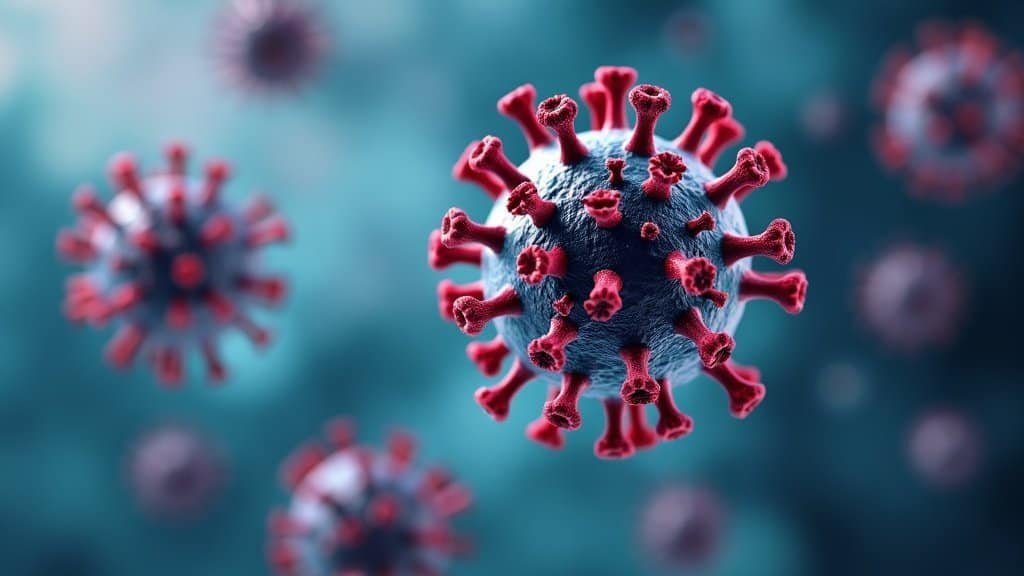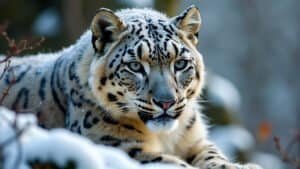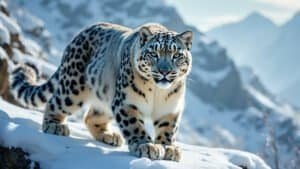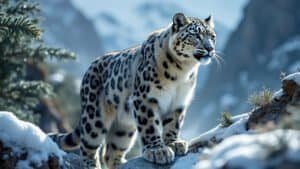Introduction
Snow leopards, known for their elusive nature and majestic presence in high-altitude habitats, face various genetic challenges that threaten their survival
This article delves into the common genetic disorders identified in snow leopards, examining how these diseases impact their health, reproduction, and overall conservation efforts
Additionally, it compares genetic diseases in snow leopards with those in other big cats, highlighting ongoing research aimed at preserving this endangered species
Common Genetic Disorders in Snow Leopards
Snow leopards, a symbol of the rugged beauty of the Himalayas and Central Asia, are increasingly under threat due to various genetic disorders that compromise their survival
These majestic big cats, already challenged by habitat loss and poaching, also face internal struggles in the form of inherited diseases. Understanding these genetic issues is crucial for developing effective conservation strategies that ensure the health and viability of snow leopard populations
Types of Genetic Diseases Identified
Snow leopards are susceptible to a range of genetic diseases, some of which are common among other big cats, while others are more specific to their species
One of the primary concerns is cystinuria, a condition that affects the kidney’s ability to reabsorb cystine, leading to the formation of stones in the urinary tract. This disease, although rare, can be particularly debilitating, causing pain, infection, and even death if not managed properly
Another significant genetic disorder found in snow leopards is cardiomyopathy, a disease that affects the heart muscle. This condition leads to weakened heart function, making it difficult for the animal to pump blood efficiently
Cardiomyopathy is often a hereditary condition, meaning it can be passed down through generations, potentially affecting a large segment of the population if not addressed
In addition to these, snow leopards are also at risk of polycystic kidney disease (PKD), a condition where cysts form in the kidneys, leading to organ failure over time. This disease is particularly concerning as it can go unnoticed until the animal is severely ill, making early detection and management critical
Prevalence and Impact on Population Health
The prevalence of these genetic disorders in snow leopard populations varies, but their impact is universally significant. For example, a study by Janecka et al. (2017) found that up to 15% of snow leopards in certain captive populations exhibited symptoms of cystinuria
This high incidence rate is alarming, especially considering the small, fragmented populations of snow leopards both in the wild and in captivity
Cardiomyopathy, although less common, poses a serious threat due to its chronic nature. Affected snow leopards may exhibit reduced stamina and are more prone to sudden cardiac arrest
This condition not only shortens the lifespan of the individual animals but also affects their reproductive success, as weakened individuals are less likely to mate successfully or rear healthy offspring
Polycystic kidney disease, on the other hand, is particularly insidious. As highlighted in the research by Armstrong et al. (2021), PKD can remain undetected for years, slowly degrading the animal’s health until it becomes critical
The impact of PKD on snow leopard populations is compounded by the fact that there are no definitive cures for the condition, making it a significant focus for ongoing research
Genetic Testing and Diagnosis
The identification of these genetic diseases has been greatly enhanced by advances in genetic testing and diagnostic techniques. Modern techniques such as whole genome sequencing allow for the detection of genetic mutations associated with diseases like cystinuria and cardiomyopathy
For instance, the Snow Leopard Trust has been working with veterinary geneticists to develop targeted genetic tests that can identify carriers of these diseases within both wild and captive populations
Moreover, genetic testing is not just about disease detection; it also plays a crucial role in managing breeding programs. By identifying carriers of harmful genetic traits, conservationists can make informed decisions to minimize the spread of these diseases in future generations. This proactive approach is essential in maintaining genetic diversity and overall population health
The presence of genetic disorders such as cystinuria, cardiomyopathy, and polycystic kidney disease in snow leopards represents a significant challenge to their conservation
The ongoing research and application of genetic testing are vital tools in the fight to preserve these endangered animals, ensuring that they remain a part of the world’s natural heritage for generations to come
Implications of Genetic Diseases on Conservation Efforts
Genetic diseases in snow leopards present substantial challenges to conservationists striving to protect this endangered species
The presence of inherited disorders such as cystinuria, cardiomyopathy, and polycystic kidney disease complicates breeding programs, influences conservation strategies, and underscores the need for proactive management of both wild and captive populations
Understanding these implications is key to developing effective conservation practices that not only preserve the snow leopard but also ensure its long-term survival in the wild
Effects on Breeding Programs
Breeding programs, especially those involving endangered species like snow leopards, are designed to maximize genetic diversity and strengthen population numbers
However, the existence of genetic diseases introduces complexities that can undermine these goals. For instance, breeding individuals who carry harmful recessive genes for disorders such as cystinuria can result in offspring that express the disease, leading to significant health challenges and reduced survival rates
A critical concern is the potential for inbreeding depression, a phenomenon where closely related individuals breed and increase the likelihood of genetic diseases manifesting in the population
This risk is particularly high in small, isolated populations, which is often the case for snow leopards in the wild. In captive breeding programs, careful genetic management is essential to avoid this pitfall. Tools such as pedigree analysis and genetic screening help conservationists identify at-risk individuals and plan matings that minimize the transmission of deleterious genes
For example, a study by Henry et al. (2020) on snow leopard breeding programs found that by using genetic data to guide breeding decisions, the incidence of cystinuria was reduced in captive populations
This proactive approach not only helps maintain healthier individuals but also supports the long-term viability of the species by ensuring that genetic diversity is preserved
Conservation Strategies to Address Genetic Issues
The management of genetic diseases in snow leopards extends beyond breeding programs to broader conservation strategies. In the wild, these strategies include maintaining genetic connectivity between populations to prevent inbreeding and the accumulation of harmful genetic mutations
Conservationists often work to establish wildlife corridors that allow snow leopards to move between isolated habitats, thereby promoting gene flow and reducing the risk of genetic diseases becoming widespread
In addition, genetic rescue is a technique that has been considered for snow leopards. This involves introducing individuals from genetically diverse populations to those with higher levels of inbreeding, thereby increasing genetic variability and reducing the prevalence of genetic disorders
However, this approach requires careful planning to avoid disrupting local adaptations and ensuring that the introduced individuals can thrive in the new environment
Captive populations also play a critical role in conservation efforts, serving as genetic reservoirs that can be used to bolster wild populations if needed. However, managing genetic diseases in captivity requires continuous monitoring and research
For example, ongoing studies into the genetic basis of diseases like cardiomyopathy help identify at-risk individuals early, allowing for targeted interventions that can prevent the spread of these conditions within the population
Role of Zoos and Wildlife Reserves
Zoos and wildlife reserves are essential in the conservation of snow leopards, particularly when it comes to managing genetic health
These institutions not only provide a controlled environment where genetic diseases can be studied and managed but also serve as centers for public education and awareness about the challenges facing snow leopards
Zoos participating in Species Survival Plans (SSPs) work collaboratively to manage the genetic health of snow leopards in captivity. By sharing genetic data and coordinating breeding efforts, these institutions help maintain a genetically healthy and diverse population that can potentially be reintroduced into the wild
The involvement of veterinary experts and geneticists in these programs ensures that genetic disorders are identified and managed effectively, reducing their impact on the population
Wildlife reserves, on the other hand, focus on maintaining healthy wild populations. These reserves often engage in non-invasive genetic monitoring, such as collecting and analyzing scat samples, to assess the genetic health of snow leopard populations without disrupting their natural behaviors
This data is invaluable for informing conservation strategies and identifying populations that may be at risk of genetic diseases
The implications of genetic diseases in snow leopards are far-reaching, affecting both breeding programs and broader conservation efforts. By integrating genetic management into conservation strategies, and leveraging the roles of zoos and wildlife reserves, it is possible to mitigate these challenges and work towards the long-term preservation of this iconic species
Genetic Diseases and Snow Leopard Reproduction
Genetic diseases not only affect the overall health of snow leopards but also have significant implications for their reproduction. The ability of snow leopards to reproduce successfully is crucial for the survival of the species, especially given their endangered status
Genetic disorders can hinder reproductive success, lead to complications in offspring, and necessitate targeted research to improve the genetic health of both wild and captive populations
Influence on Fertility Rates
One of the primary ways genetic diseases impact snow leopard reproduction is through their influence on fertility rates. Genetic disorders such as cystinuria and cardiomyopathy can lead to reduced fertility in affected individuals
For example, animals suffering from severe cystinuria may experience chronic pain or discomfort, which can reduce their overall health and, consequently, their reproductive capabilities
In males, genetic diseases that affect the kidneys or urinary tract, like cystinuria, can lead to complications such as blockages, which may interfere with normal reproductive functions. Similarly, genetic conditions that weaken the heart, like cardiomyopathy, can reduce stamina and overall health, making it less likely for males to successfully mate and reproduce
For females, the presence of genetic diseases can lead to complications during pregnancy or affect the ability to carry a pregnancy to term
The stress of managing a chronic genetic condition, combined with the physical demands of pregnancy, can result in lower fertility rates or higher rates of pregnancy loss. This is particularly concerning in small, isolated populations where every reproductive event is critical to maintaining population numbers
Inherited Disorders Affecting Cubs
The impact of genetic diseases on reproduction extends beyond the parents to their offspring. Cubs born to parents carrying harmful genetic mutations are at risk of inheriting these disorders, which can manifest in various ways
For instance, if both parents are carriers of a recessive gene for a condition like polycystic kidney disease (PKD), there is a higher likelihood that their offspring will inherit the disease. Cubs born with PKD may appear healthy at birth but could develop severe kidney issues as they age, leading to a shortened lifespan and reduced reproductive potential
Moreover, the presence of genetic diseases in cubs can lead to higher infant mortality rates, which further impacts population dynamics. In wild populations, where survival rates are already challenged by environmental factors, the added burden of genetic diseases can significantly reduce the number of cubs that reach maturity
In captivity, where breeding programs aim to maximize the number of healthy offspring, the occurrence of genetic diseases can lead to difficult decisions about whether to breed certain individuals or how to manage affected cubs
Research on Improving Genetic Health
To address these challenges, ongoing research is focused on improving the genetic health of snow leopards. One key area of research involves the development of genetic screening programs that can identify carriers of harmful genetic mutations before they are bred
By using tools such as whole genome sequencing and gene editing, scientists can gain a deeper understanding of the genetic makeup of snow leopards and identify specific mutations linked to diseases like cystinuria, cardiomyopathy, and PKD
In some cases, assisted reproductive technologies (ARTs), such as artificial insemination and embryo transfer, are being explored as ways to bypass genetic issues and increase reproductive success
These technologies allow conservationists to select the healthiest, genetically diverse individuals for breeding, while minimizing the risk of passing on harmful genetic traits. For example, sperm or eggs from genetically healthy individuals can be used to create embryos that are free from certain genetic disorders, which can then be implanted into surrogate mothers
Another important aspect of this research is the study of epigenetics, which looks at how environmental factors can influence the expression of genetic traits
Understanding how diet, stress, and other external factors affect the manifestation of genetic diseases could lead to new strategies for managing these conditions in snow leopards, potentially reducing their impact on reproduction
Genetic diseases have a profound effect on the reproductive success of snow leopards, influencing both fertility rates and the health of offspring
Through targeted research and the application of advanced genetic technologies, conservationists are working to improve the genetic health of snow leopards, ensuring that these magnificent animals continue to thrive in the wild and in captivity
Comparative Analysis of Genetic Diseases in Big Cats
Genetic diseases are a concern for many big cat species, but each species, including the snow leopard, faces unique challenges. Understanding how genetic diseases affect snow leopards in comparison to other big cats like lions, tigers, and leopards provides valuable insights that can inform conservation strategies. This comparative analysis explores the similarities and differences in genetic health across these species, shedding light on the unique genetic challenges snow leopards face and the lessons that can be learned from other big cats.
Similarities with Other Big Cats
Snow leopards share several genetic vulnerabilities with other big cat species. For example, cardiomyopathy is a genetic disease found not only in snow leopards but also in lions, tigers, and domestic cats
This condition affects the heart muscle, leading to a weakened heart and, ultimately, heart failure. The genetic mutations responsible for cardiomyopathy have been identified in multiple big cat species, suggesting that this disease might be a common issue among felids
Similarly, polycystic kidney disease (PKD) is another condition found in snow leopards that is also present in other big cats, particularly domestic cats and lions. PKD causes the formation of cysts in the kidneys, leading to kidney failure over time
This disease has been well-documented in domestic cats, and the genetic mutation responsible for PKD has been identified, allowing for genetic screening in captive breeding programs. The knowledge gained from studying PKD in domestic cats has been instrumental in managing this disease in snow leopards and other big cats
Another example is cystinuria, a condition affecting the kidneys and urinary tract, which has been observed in both snow leopards and other big cats like lions and cheetahs
The genetic mutation that causes cystinuria in these species is similar, allowing researchers to apply findings from one species to others. This cross-species understanding is crucial for developing effective treatments and management strategies
Unique Genetic Challenges in Snow Leopards
While snow leopards share some genetic diseases with other big cats, they also face unique genetic challenges due to their distinct evolutionary history and isolated habitats
One of the most significant challenges is the low genetic diversity found in snow leopard populations. Due to their fragmented habitats and small population sizes, snow leopards have a limited gene pool, making them more susceptible to inbreeding and the associated increase in genetic disorders
This low genetic diversity is less of an issue in species like lions and tigers, which have larger populations and more opportunities for gene flow between different groups
For snow leopards, however, the isolation of populations in remote mountainous regions means that genetic diseases can spread more easily within a population and become entrenched over time
Another unique challenge for snow leopards is their susceptibility to genetic drift, a phenomenon where random changes in allele frequencies can lead to the loss of genetic variation
In small, isolated populations like those of snow leopards, genetic drift can lead to the fixation of harmful genetic mutations, exacerbating the impact of genetic diseases. This is less of a concern in larger, more genetically diverse species like tigers, where genetic drift has less of an impact on population health
Lessons Learned from Comparative Studies
The comparative study of genetic diseases across big cat species has provided valuable lessons that can be applied to snow leopard conservation. For example, the use of genetic screening to manage breeding in lions and tigers has been highly effective in reducing the prevalence of genetic diseases in captive populations
These screening programs have been adapted for snow leopards, helping to identify carriers of harmful genetic mutations and prevent the spread of these conditions in breeding programs
Another lesson comes from the study of genetic diversity in other big cats. Conservationists working with species like cheetahs, which also suffer from low genetic diversity, have developed strategies to increase gene flow between isolated populations, such as translocation programs and the creation of wildlife corridors
These strategies are now being considered for snow leopards to help mitigate the effects of genetic drift and reduce the prevalence of genetic diseases
The study of epigenetics in other big cats has also provided insights into how environmental factors can influence the expression of genetic traits. For example, research on lions and tigers has shown that stress and diet can impact the severity of genetic diseases like cardiomyopathy
These findings are being used to explore how similar factors might affect snow leopards, potentially leading to new strategies for managing genetic diseases in this species
While snow leopards share some genetic diseases with other big cats, they also face unique challenges due to their low genetic diversity and isolated populations
By learning from the experiences of other big cat species, conservationists can develop more effective strategies to manage genetic diseases in snow leopards and ensure the long-term survival of this iconic species
Conclusion
Genetic diseases pose significant challenges to the conservation of snow leopards, impacting their health, reproduction, and overall population viability. The prevalence of disorders such as cystinuria, cardiomyopathy, and polycystic kidney disease highlights the importance of genetic management in both wild and captive populations
Comparative studies with other big cats provide valuable insights, revealing shared vulnerabilities and unique challenges that snow leopards face due to their low genetic diversity and isolated habitats
By integrating advanced genetic screening, research, and conservation strategies, it is possible to mitigate the impact of these genetic diseases and support the long-term survival of snow leopards in their natural habitats. Continued efforts in this area are essential for preserving this majestic species for future generations













